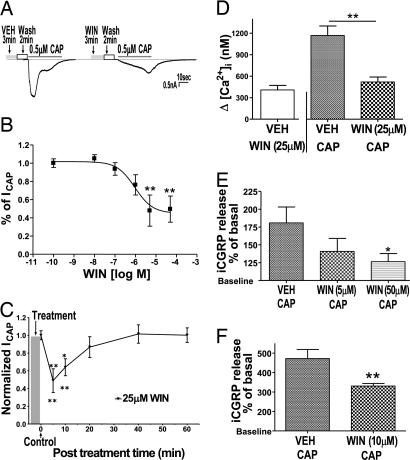Fig. 1.
The cannabinoid agonist WIN 55,212-2 (WIN) reversibly inhibits capsaicin responses from nociceptors. (A) Effect of vehicle (VEH) or WIN pretreatment on capsaicin-induced inward current in cultured rat TG neurons. Cultured TG neurons were grown in presence of nerve growth factor (NGF) for 24–48 h. The intact neurons were exposed to VEH/WIN (25 μM) for 3 min, washed for 2 min, and then ICAP [0.5 μM capsaicin (CAP) for 40 s] were recorded in whole-cell configuration. Representative traces denote capsaicin current (ICAP) after VEH or WIN treatment. (B) Effect of pretreatment with different concentrations of WIN on Icap. Data are normalized to ICAP after VEH pretreatment (n = 8–13 cells per condition; ∗∗, P < 0.01, ANOVA with Bonferroni post hoc test). (C) The time course of WIN (25 μM for 3 min, then wash) inhibition of ICAP is shown (n = 8–12 cells per condition; ∗, P < 0.05; ∗∗, P < 0.01, ANOVA with Bonferroni post hoc test). (D) Effect of VEH or WIN (25 μM) pretreatment on capsaicin-induced calcium influx in cultured TG neurons. The Fura-loaded cells were exposed to either vehicle or WIN (25 μM) for 3 min. After the WIN-induced calcium influx returned to the basal level, the cells were exposed to capsaicin (0.5 μM for 40 s). The elevation (Δ) in [Ca2+]i in VEH-WIN group denotes the calcium influx evoked by WIN alone over baseline values, and the elevation (Δ) in [Ca2+]i in the VEH-CAP and WIN-CAP groups denotes the CAP-evoked calcium influx over baseline levels after VEH or WIN pretreatment (n = 16–25; ∗∗, P < 0.05, ANOVA with Bonferroni post hoc test). (E) Effect of VEH or WIN pretreatment on capsaicin-induced CGRP release from acutely dissociated rat TG neurons. Freshly isolated and dissociated TG were pretreated with either vehicle or WIN for 7 min, washed, and then pulsed with capsaicin alone (100 μM) for 2 min. Capsaicin-evoked iCGRP release was measured by radioimmunoassay (RIA) and is represented as percent of basal release (n = 8; ∗, P < 0.05, ANOVA with Bonferroni post hoc test). (F) Effect of VEH or WIN pretreatment on capsaicin-induced CGRP release from acutely isolated hindpaw skin. Freshly isolated hindpaw skin was pretreated with VEH or WIN (10 μM), washed (10 min), and then pulsed with capsaicin alone (100 μM) for 2 min. Capsaicin-evoked iCGRP release was measured by RIA and is represented as percent of basal release (n = 6; ∗∗, P < 0.01, Student’s t test).

